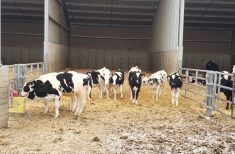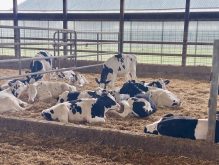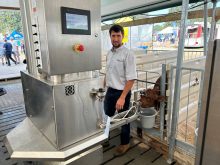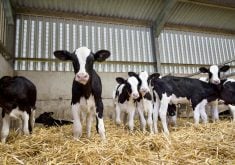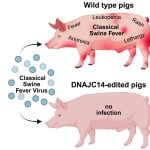Examining all calves before transport and following the same nutrition and care protocols for male and female newborns could improve health outcomes for dairy farm animals that eventually end up at veal facilities.
University of Guelph PhD student Dr. Devon Wilson, now working in the Population Medicine lab of Dr. Dave Renaud, spoke about calf transport during the Veal Farmers of Ontario-hosted Healthy Calf Conference Nov. 30 in Stratford.
Why it matters: Farms specializing in veal or dairy-beef crosses want to receive healthy animals so costs of treatment and mortality are minimized.
Read Also

Improving calf health, fighting pesticide resistance highlighted at Canada’s Outdoor Farm Show
New strides in agricultural innovation including improving calf health, fighting pesticide resistance were the featured topic at the University of Guelph Feeding The Future discussion at Canada’s Outdoor Farm Show 2025.
Wilson said calves being transported should meet the four H’s – healthy, heavy, hydrated and having high immunity.
A study of 1,000 calves arriving at a veal facility in Ontario showed 10 to 20 per cent had an abnormal “attitude,” fecal score or nasal discharge, she said. A study of approximately 4,000 calves coming from dairy farms to auction markets in Quebec and British Columbia revealed an even higher percentage with “an observable abnormality.”
[RELATED] South Western Ontario Dairy Symposium returns in-person
It’s unclear from these studies whether the conditions developed during transport or on the farm of origin. So, for her PhD work, Wilson looked into the day before shipping on the farm.
An assessment of calves on 17 B.C. farms showed the average of those with an abnormality on day of shipping at 19 per cent. The worst farm had 45 per cent of calves affected and the best had none.
“You could see a huge variation in what people were shipping,” she said.
Excellent neonatal care is the main key to having healthy calves on the day of shipping, Wilson noted, but even that isn’t foolproof. And, though one B.C. farm shipped no sick calves during her study, “things are going to slip. We are going to have sick calves. We just have to make sure they’re not transported.”
One troubling trend revealed in European and North American research is that some dairy farms have different colostrum management programs for male versus female calves. The passive transfer of immunity achieved through proper colostrum feeding has been shown to positively affect health outcomes. Newborns that don’t get best-practice colostrum care are at greater risk.
Wilson said best practices include following the same time to first colostrum feeding, quantity fed, and percentage of feeding that consists of high-quality colostrum for both male and female newborns.
[RELATED] Ontario dairy producers, industry leaders recognized
The age and weight of calves being shipped are additional factors.
A recent survey of dairy producers in Ontario and the Atlantic provinces revealed almost 30 per cent marketed calves between one and seven days old. Nearly 40 per cent shipped calves at seven to 10 days.
Meanwhile, a recent study in which Wilson was involved showed that Holstein calves arriving at calf-raising facilities were typically bigger than the beef crosses but weight is most strongly related to age.
Of the 1,000 calves shipped in B.C., the minimum weight at arrival was 34 kilograms, the average was 43 kg and the maximum was more than 50.
The best practice suggested in industry-sanctioned livestock care protocols is to wait until calves weigh more than 50 kg. A large study across three countries and nearly 200 farms in Europe showed a significant incidence of respiratory illness in three weight-based sub-categories below 50 kg but very little incidence among those above the cut-off.
In typical Holstein environments, this translates to 14 days of age. It requires good nutrition for pregnant and neo-natal cows, thereby supporting heavier birth weights.
“I do think those cut points are currently a work in progress,” Wilson said. “This is currently what’s supported in research.”
But the takeaway message is to ship calves as heavy and as old as possible.
She also called on dairy producers to evaluate every calf being shipped off the farm. This includes joints, muzzles, ears, eyes, navel and butt.
“If every farmer examined every calf, I don’t think we would have as high as 40 per cent shipped with some kind of health abnormality.”




